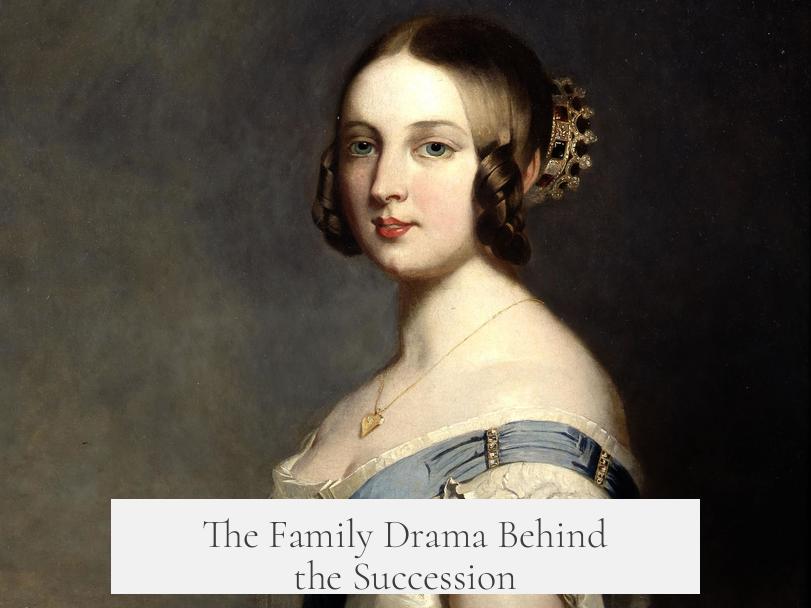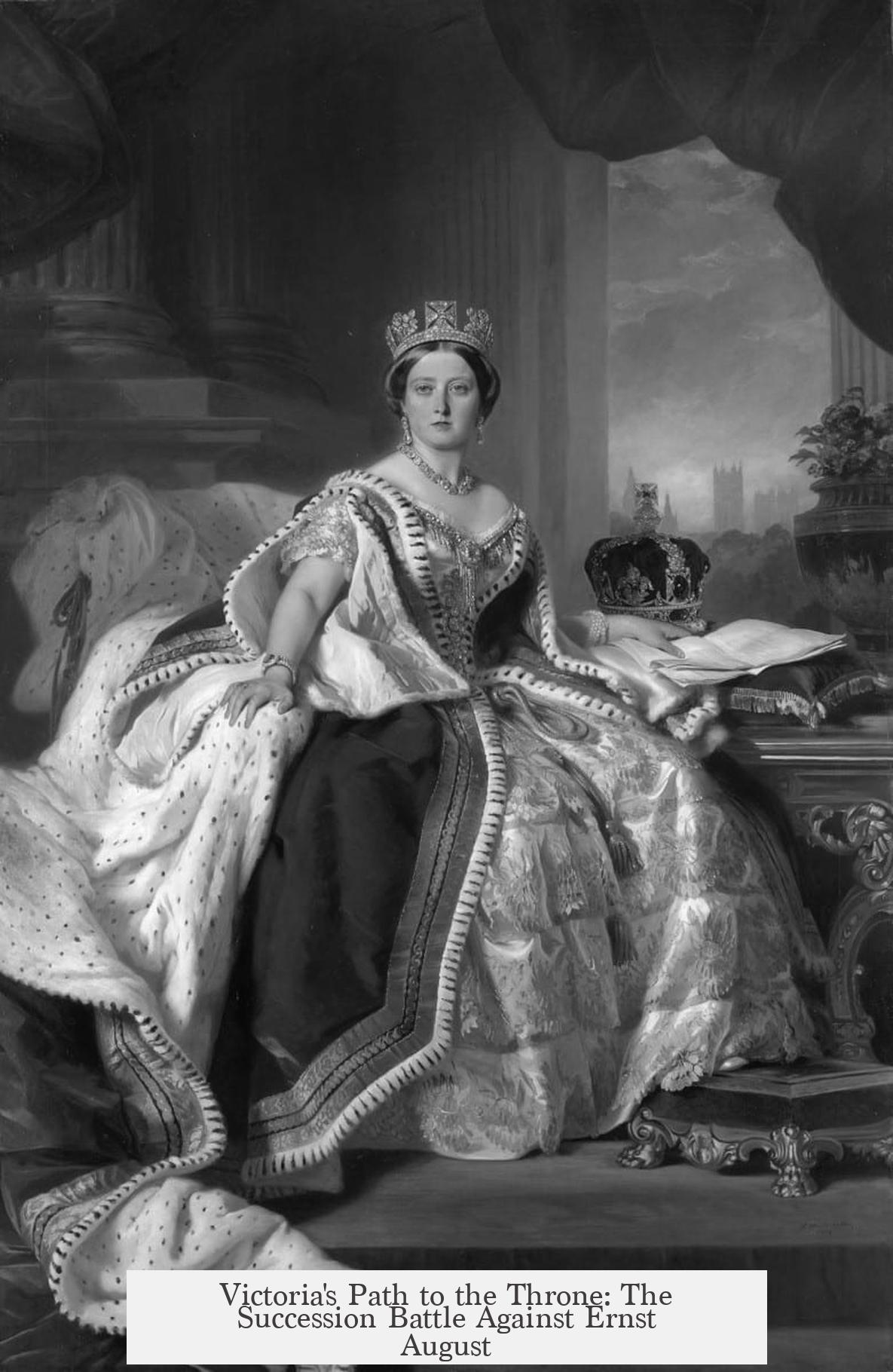Victoria succeeded to the British throne instead of Ernest Augustus due to differences in succession laws between the United Kingdom and Hanover, combined with the specific family circumstances of King George III’s descendants.
The United Kingdom followed male-preference primogeniture succession, which allowed a daughter to inherit the throne if there were no surviving legitimate sons in her branch. Victoria, as the daughter of Edward, Duke of Kent (the fourth son of George III), inherited before her father’s younger brothers under this system. In contrast, Hanover adhered strictly to Salic law, barring women entirely from succession, which allowed Ernest Augustus, a younger son of George III, to inherit Hanover’s crown.
British law prioritized the children of older sons over younger sons, even favoring daughters over their uncles. Upon the death of Edward, Duke of Kent, his only child, Alexandrina Victoria (later Queen Victoria), became the rightful heir because her father was an older son than Ernest Augustus. Even though male siblings were preferred, Victorian law favored an older son’s offspring before moving on to younger brothers without issue.
| Succession Laws | United Kingdom | Hanover |
|---|---|---|
| Law Type | Male-Preference Primogeniture | Salic Law |
| Eligibility of Women | Allowed if no male descendants in same branch | Excluded entirely from succession |
| Succession Priority | Oldest son’s children before younger sons | Male descendants only |
When George III’s eldest legitimate granddaughter, Princess Charlotte of Wales, died in 1817 without surviving issue, the succession focus shifted to his other sons. Prince George, later George IV, had no surviving children. Prince Frederick had none. William IV had no legitimate offspring. This left Edward, Duke of Kent, whose only surviving child was Victoria. Edward died in 1820, leaving Victoria next in line under British law.
Ernest Augustus, the fifth son of George III, had a son named George, born three days after Victoria. While this son would have secured Ernest Augustus’s claim had Victoria not been born or died young, British succession laws still placed Victoria ahead. Conversely, Hanover’s strict Salic law excluded Victoria from succession, leading Ernest Augustus to inherit Hanover’s throne in 1837 after William IV’s death.
In essence, the key to Victoria’s succession lies in the contrast of inheritance laws. Britain’s law allowed daughters to inherit when no surviving sons were available, preserving the elder brother’s line through his child. Hanover’s law excluded females entirely, favoring the next male sibling. This divergence ended the personal union between Britain and Hanover, splitting the crowns after 1837.
Victoria became Queen of the United Kingdom at just 18 years old following William IV’s death. Her accession marked the continuation of the senior male line through Edward’s lineage, despite her gender. Ernest Augustus only inherited the Kingdom of Hanover due to the enforcement of Salic law there.
- The UK used male-preference primogeniture, allowing women to inherit if no surviving male offspring were present in their branch.
- Victoria was the daughter of an older son of George III, securing her precedence over younger brothers under British law.
- Hanover adhered to Salic law, excluding women entirely from succession, so Ernest Augustus inherited there.
- The death of Princess Charlotte of Wales, with no surviving issue, shifted succession focus to Edward’s line in the UK.
- Ernest Augustus’s claim in Britain was blocked by Victoria’s birth and her position in the succession order.
Why Did Victoria Succeed Instead of Ernst August?

The main reason Victoria ascended the British throne instead of her uncle Ernst August boils down to the differences between British and Hanoverian succession laws. The UK followed male-preference primogeniture, which allowed a daughter to inherit in the absence of a surviving son, while Hanover strictly applied Salic law, forbidding female succession entirely. Let’s untangle this fascinating historical drama and see why history crowned Victoria queen, not Ernst August.
Who knew that royal succession could be so technical, yet dramatic?
The British Succession Puzzle: Male-Preference Primogeniture
In the UK, succession follows a male-preference primogeniture system. What does that mean? Simply put, the throne passes first to the monarch’s oldest son. If he’s no longer around, then to his eldest son, and so forth down the male line.
But—and here’s the twist—if no sons survive in that branch, the eldest daughter of the eldest son claims the throne before any younger brothers of the current monarch or their children get a look-in. In other words, daughters can inherit—but only when no sons are left in the senior male line.
Victoria’s father, Edward, Duke of Kent, was George III’s fourth son and had just one surviving child—Victoria. Edward died when Victoria was just a baby, but under British law, his rights passed on to her. Thus, she outranked her uncles, the younger sons of George III, in the royal succession stakes.
- Oldest son’s male descendants come first.
- If no sons survive, oldest son’s daughters come next.
- The throne only passes to the younger brothers or their offspring if the eldest son’s line is extinct.
Salic Law in Hanover: No Women Allowed
Now, switch over to Hanover, where the rules are stricter. Hanover adhered to Salic law. This law is famously clear about its stance:
“No portion of the inheritance shall come to a woman; the whole inheritance of the land shall come to the male sex.”
Simply put, no queens in Hanover. Women were completely excluded from succession. This meant Victoria’s claim was invalid there, and that the throne would pass to the next eligible male heir.
Enter Ernest Augustus, George III’s fifth son and the man poised to inherit Hanover. He had a legitimate son, George, born just three days after Victoria. If Victoria hadn’t been born or had died young, Ernest Augustus would have taken both thrones.
The Family Drama Behind the Succession

The succession story isn’t just about laws. It’s deeply rooted in family tragedies and alliances.
Charlotte, Princess of Wales, was the only legitimate child of George IV (then Prince Regent) and seemed destined to continue the royal line. She married Prince Leopold and had hope for heirs. However, tragedy struck when she delivered a stillborn son and died shortly after, leaving no surviving legitimate heirs from the eldest son.
Following Charlotte’s death, George III’s other sons scrambled to provide legitimate heirs to maintain the royal lineage. Victoria’s father, Edward, was the oldest surviving son with a legitimate offspring after 1817 – his daughter Victoria. Meanwhile, elder brothers George IV and William IV had either no surviving legitimate children or no legitimate children at all. Therefore, Edward’s daughter naturally became the heiress.
How Succession Shaped 1837
| George III’s Sons | Status in 1837 | Children Status |
|---|---|---|
| George IV (Prince Regent) | Died 1830 | No surviving legitimate children (Charlotte’s death in 1817) |
| Prince Frederick | Died 1827 | No children |
| William IV | Died 1837 | No legitimate children |
| Edward, Duke of Kent | Died 1820 | One daughter: Victoria |
| Ernest Augustus | Alive | One son: George of Hanover |
When William IV died in 1837, the senior line was extinct except for Victoria, now 18 years old. British law pointed to her as the rightful heir, while Hanoverian law rejected her completely. The stage was set for a historic split: Victoria became Queen of the United Kingdom, while Ernest Augustus ascended the throne of Hanover.
Uncle vs. Niece: A Royal Rivalry
Royal family politics could be dramatic. Rumors swirled that some of Victoria’s uncles weren’t exactly thrilled at her rise and might have plotted against her to clear their own path to the throne.
Now, we can’t fact-check palace whispers with certainty, but it certainly adds spice to the story. Yet, through it all, Victoria survived and flourished, eventually becoming one of Britain’s longest-reigning monarchs.
Lessons from History: Why Succession Laws Matter

This tale is a prime example of how legal nuances can shape history. The difference between male-preference primogeniture and Salic law wasn’t just a dry detail—it literally split empires and dictated who would wear the crown.
Victoria’s success shows how a single law can elevate a young woman to the throne, even in an era overwhelmingly dominated by men. Meanwhile, Hanover’s adherence to strict male-only inheritance laws reminds us that traditions can vary dramatically based on local customs and histories.
Had Victoria never been born or tragically passed away, Ernest Augustus would have worn both crowns. So, her success underscores the importance of timing, birth order, and the intricate dance of royal succession laws.
Wrapping It Up: Why Victoria Won the Crown Over Ernst August
- UK’s male-preference primogeniture favored Victoria because she was the daughter of the oldest son with no surviving brothers or nephews.
- Ernest Augustus was sidelined for the British throne due to seniority rules prioritizing descendants of older brothers.
- Hanover’s Salic law prohibited Victoria from inheriting, awarding the Hanoverian crown to Ernest Augustus.
- The deaths of Charlotte and failure of other older brothers to produce legitimate heirs paved the way for Victoria’s accession.
- Succession laws and family circumstances together crafted a remarkable historical divergence.
Navigating the royal succession maze is like untangling a vintage necklace—very delicate, intricate, and sometimes full of surprises.
But one thing shines through: Victoria’s rise was no accident. It was the product of legal rules, family tragedy, and a spot of good timing. A queen was crowned, while her uncle ruled elsewhere. History, with all its twisting staircases, chose Victoria to reign over Britain.
So next time you think monarchy is just pomp and circumstance, remember how much planning—and legal quirkiness—goes into crowning a king or queen.
Why did Victoria inherit the British throne instead of her uncle Ernst August?
British succession law favored descendants of older sons over younger brothers. Victoria was the daughter of the eldest son with surviving children. This gave her priority over Ernest Augustus, a younger son of George III.
How did the succession laws of the UK and Hanover differ?
The UK used male-preference primogeniture, allowing women to inherit if no sons survived. Hanover followed Salic law, which barred women completely from inheriting the throne.
What role did the Salic law play in Ernst August inheriting Hanover?
Salic law excluded women from succession in Hanover. This meant Victoria could not inherit there, so Ernst Augustus, as the oldest living male, became king of Hanover.
Why was Victoria’s claim stronger than Ernest Augustus’s claim in the UK?
Victoria was the daughter of the eldest son with surviving children. British law favored descendants of older sons, so her father’s claim passed to her, excluding younger brothers like Ernst Augustus.
Could Ernest Augustus have inherited both thrones?
Had Victoria not been born or died before 1837, Ernst Augustus would have inherited both. Victoria’s birth ensured the UK crown passed to her, but Hanover’s laws gave Ernst Augustus its throne.




